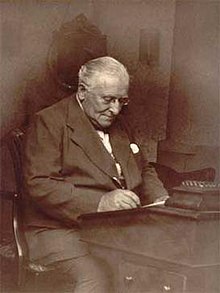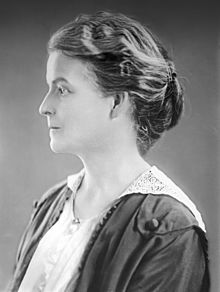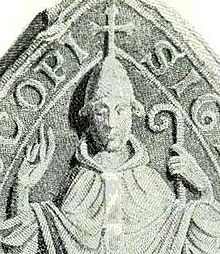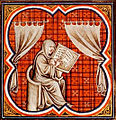Portal:Biography
The Biography Portal
A biography, or simply bio, is a detailed description of a person's life. It involves more than just basic facts like education, work, relationships, and death; it portrays a person's experience of these life events. Unlike a profile or curriculum vitae (résumé), a biography presents a subject's life story, highlighting various aspects of their life, including intimate details of experience, and may include an analysis of the subject's personality.
Biographical works are usually non-fiction, but fiction can also be used to portray a person's life. One in-depth form of biographical coverage is called legacy writing. Works in diverse media, from literature to film, form the genre known as biography.
An authorized biography is written with the permission, cooperation, and at times, participation of a subject or a subject's heirs. An autobiography is written by the person themselves, sometimes with the assistance of a collaborator or ghostwriter. (Full article...)
Featured biographies –
In 1938, he moved to the United States as the recipient of a two-year Rockefeller fellowship and conducted research at Harvard University before joining the academic staff of Stanford University. During World War II, Tomasevich worked for the Board of Economic Warfare and the United Nations Relief and Rehabilitation Administration, and post-war he joined the Federal Reserve Bank in San Francisco. In 1948, he joined the staff at San Francisco State College (later San Francisco State University). He combined research and teaching there for twenty-five years until his retirement in 1973, which was broken by a year of teaching at Columbia University in 1954. Between 1943 and 1955, Tomasevich published two positively reviewed books on economic matters; one focused on marine resources and the other on the peasant economy of Yugoslavia. (Full article...)

Albert William Ketèlbey (/kəˈtɛlbi/; born Ketelbey; 9 August 1875 – 26 November 1959) was an English composer, conductor and pianist, best known for his short pieces of light orchestral music. He was born in Birmingham and moved to London in 1889 to study at Trinity College of Music. After a brilliant studentship he did not pursue the classical career predicted for him, becoming musical director of the Vaudeville Theatre before gaining fame as a composer of light music and as a conductor of his own works.
For many years Ketèlbey worked for a series of music publishers, including Chappell & Co and the Columbia Graphophone Company, making arrangements for smaller orchestras, a period in which he learned to write fluent and popular music. He also found great success writing music for silent films until the advent of talking films in the late 1920s. (Full article...)
William the Conqueror (c. 1028 – 9 September 1087), sometimes called William the Bastard, was the first Norman king of England (as William I), reigning from 1066 until his death. A descendant of Rollo, he was Duke of Normandy (as William II) from 1035 onward. By 1060, following a long struggle, his hold on Normandy was secure. In 1066, following the death of Edward the Confessor, William invaded England, leading an army of Normans to victory over the Anglo-Saxon forces of Harold Godwinson at the Battle of Hastings, and suppressed subsequent English revolts in what has become known as the Norman Conquest. The rest of his life was marked by struggles to consolidate his hold over England and his continental lands, and by difficulties with his eldest son, Robert Curthose.
William was the son of the unmarried Duke Robert I of Normandy and his mistress Herleva. His illegitimate status and youth caused some difficulties for him after he succeeded his father, as did the anarchy which plagued the first years of his rule. During his childhood and adolescence, members of the Norman aristocracy battled each other, both for control of the child duke, and for their own ends. In 1047, William quashed a rebellion and begin to establish his authority over the duchy, a process that was not complete until about 1060. His marriage in the 1050s to Matilda of Flanders provided him with a powerful ally in the neighbouring county of Flanders. By the time of his marriage, William was able to arrange the appointment of his supporters as bishops and abbots in the Norman church. His consolidation of power allowed him to expand his horizons, and he secured control of the neighbouring county of Maine by 1062. (Full article...)
John Thirtle (baptised 22 June 1777 – 30 September 1839) was an English watercolour artist and frame-maker. Born in Norwich, where he lived for most of his life, he was a leading member of the Norwich School of painters.
Much of Thirtle's life is undocumented. After working as an apprentice to a London frame-maker, he returned to Norwich to establish his own frame-making business. During his career he also worked as a drawing-master, a printseller and a looking glass maker. He produced frames for paintings by several members of the Norwich School, including John Crome and John Sell Cotman. Throughout his working life he continued to paint. In 1812 he married Elizabeth Miles, the sister of Cotman's wife Ann. Thirtle suffered from tuberculosis during the last two decades of his life, and his worsening health reduced his artistic output up to his death in 1839. His Manuscript Treatise on Watercolour, unpublished before 1977, was probably for his own use, and he exhibited fewer than 100 paintings. A member of the Norwich Society of Artists, he briefly served as its vice-president, but in 1816 was one of the artists who seceded from the Society to form a separate association, the Norfolk and Norwich Society of Artists, which dissolved after three years. (Full article...)
Alboin (530s – 28 June 572) was king of the Lombards from about 560 until 572. During his reign the Lombards ended their migrations by settling in Italy, the northern part of which Alboin conquered between 569 and 572. He had a lasting effect on Italy and the Pannonian Basin; in the former, his invasion marked the beginning of centuries of Lombard rule, and in the latter, his defeat of the Gepids and his departure from Pannonia ended the dominance there of the Germanic peoples.
The period of Alboin's reign as king in Pannonia following the death of his father, Audoin, was one of confrontation and conflict between the Lombards and their main neighbours, the Gepids. The Gepids initially gained the upper hand, but in 567, thanks to his alliance with the Avars, Alboin inflicted a decisive defeat on his enemies, whose lands the Avars subsequently occupied. The increasing power of his new neighbours caused Alboin some unease however, and he therefore decided to leave Pannonia for Italy, hoping to take advantage of the Byzantine Empire's vulnerability in defending its territory in the wake of the Gothic War. (Full article...)
Sir Thomas Neville (c. 1429 – 1460) was a medieval English politician and soldier. The second son of Richard Neville, 5th Earl of Salisbury, a major nobleman and magnate in the north of England, Sir Thomas played an active role in the violent disorder that wracked the north during the 1450s. He also took his father's side in the early years of the Wars of the Roses. Thomas was a younger brother of the more famous Richard Neville, Earl of Warwick, the 'Kingmaker'.
Thomas worked closely with them both in administering the region for the Crown and became a leading player in the turbulent regional politics of northern England in the early 1450s, especially in the Neville family's growing local rivalry with the House of Percy. In the armed feud between both houses, which broke out in 1453 and lasted two years, Thomas and his brother John launched a series of raids, ambushes and skirmishes across Yorkshire against the Percy family. Historians describe the feud as setting the stage for the Wars of the Roses, the dynastic struggle between the houses of Lancaster and York for the English throne, and Thomas played a large role in the Neville family's alliance with his uncle, Richard, Duke of York. (Full article...)
Born in 1685 in Woodstock, Oxfordshire, Hatley went to sea in 1708 as part of Woodes Rogers's expedition against the Spanish. Rogers circumnavigated the world, but Hatley was captured on the coast of present-day Ecuador and imprisoned in Lima, capital of the Viceroyalty of Peru, where he was tortured by the Inquisition. He was released and returned to Great Britain in 1713. (Full article...)
Duncan Edwards (1 October 1936 – 21 February 1958) was an English footballer who played as a left-half for Manchester United and the England national team. He was one of the Busby Babes, the young United team formed under manager Matt Busby in the mid-1950s, playing 177 matches for the club. He was noted for his physical strength, toughness, and level of authority on the pitch, and has been ranked amongst the toughest players of all time. One of eight players who died as a result of the Munich air disaster, he survived initially but succumbed to his injuries in hospital two weeks later. Many of his contemporaries have described him as one of the best, if not the best, players with whom they had played.
Born in Woodside, Dudley, Edwards signed for Manchester United as a teenager and went on to become the youngest player to play in the Football League First Division and at the time the youngest England player since the Second World War, going on to play 18 times for his country at top level. In a professional career of less than five years he helped United to win two Football League championships and two FA Charity Shields, and reach the semi-finals of the European Cup. (Full article...)
Sir John Alexander Macdonald GCB PC QC ( 10 or 11 January 1815 – 6 June 1891) was the first prime minister of Canada, serving from 1867 to 1873 and from 1878 until his death in 1891. He was the dominant figure of Canadian Confederation, and had a political career that spanned almost half a century.
Macdonald was born in Scotland; when he was a boy his family immigrated to Kingston in the Province of Upper Canada (today in eastern Ontario). As a lawyer, he was involved in several high-profile cases and quickly became prominent in Kingston, which elected him in 1844 to the legislature of the Province of Canada. By 1857, he had become premier under the colony's unstable political system. In 1864, when no party proved capable of governing for long, Macdonald agreed to a proposal from his political rival, George Brown, that the parties unite in a Great Coalition to seek federation and political reform. Macdonald was the leading figure in the subsequent discussions and conferences, which resulted in the British North America Act and the establishment of Canada as a nation on 1 July 1867. (Full article...)

















































